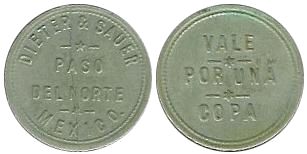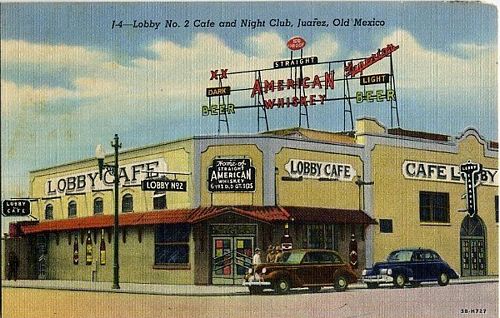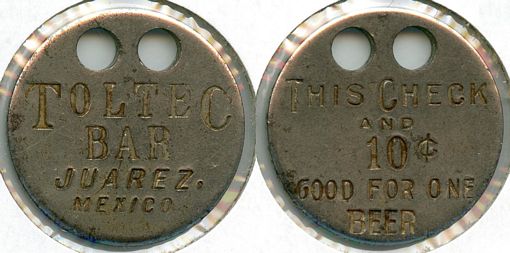Other tokens from Chihuahua - Ciudad Juárez bars
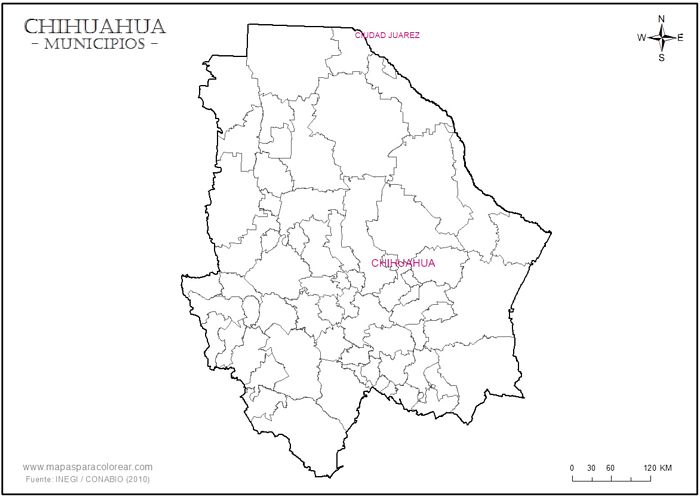
The early Ciudad Juárez bar tokens, from the beginning of the 20th century to the era around Prohibition, have a certain history and charm. The later tokens, issued from multiple clubs in a few common formats, are here merely for the sake of completeness. Despite the prurient attempts by sellers and cataloguers none of these were "brothel tokens". The images refer rather to drinking and gambling.
Big Kid's Palace Bar
H. N. Shipley was a large man known as “Big Kid”, who operated a saloon that claimed "the largest bar in the world".
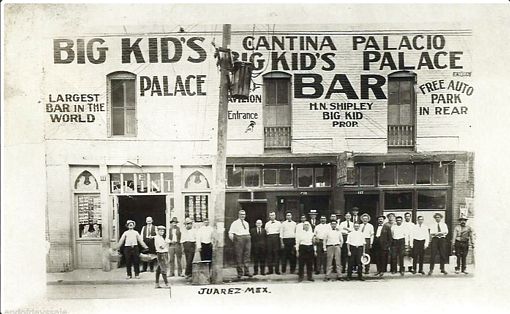
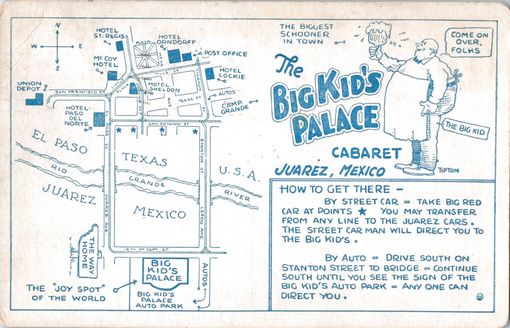
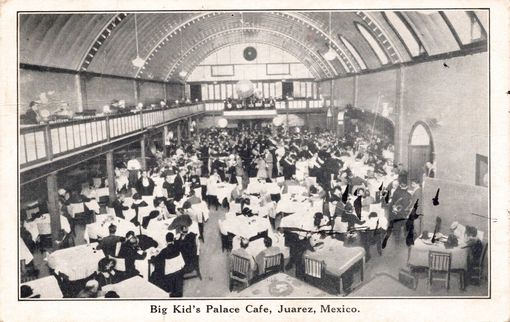
Shipley died on 24 May 1935 and his obituary read:
Harry N. Shipley, 59, the “Big Kid” to thousands of El Pasoans, died yesterday at City-County Hospital shortly after an operation.
For years one of the border’s most famous and colorful figures, the “Big Kid” died in comparative obscurity. Before his brief illness he had been tending bar in the rathskeller at Henry Mitchell’s Brewery.
It was as owner of the Gold Palace Cabaret in Juarez, known everywhere as the “Big Kid’s Palace” that Mr. Shipley rose to fame. Starting as the operator of a small bar in the Sauer Building in Juarez, he became known for the excellence of the beer he served and was able to build the Gold Palace.
Arched over with a gilt dome, the Gold Palace was crowded night after night with cash customers avoiding the prohibition-ridden United States, The “Big Kid” lived in a comfortable house, drove a large but unpretentious automobile, and looked successful in every inch of his 325-pound frame.
He hired the best orchestras for the Gold Palace and saw famous people from all over the world dancing on his floor.
Then came labor and other troubles. Business dropped off, and the Big Kid,” almost broke, was forced to give up his business.
He was in Los Angels for a while, sick and weary. ... Then he got the El Paso job, and worked until he became suddenly ill Thursday.
El Paso Times, 55th Year, No. 145, 25 May 1935 .
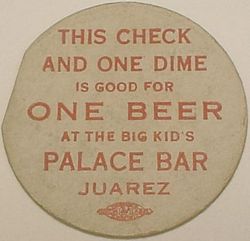
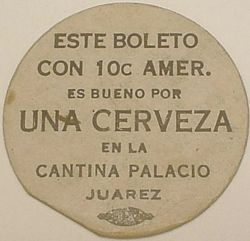
Obverse: THIS CHECK / AND ONE DIME / IS GOOD FOR / ONE BEER / AT THE BIG KID'S / PALACE BAR / JUAREZ
Reverse: ESTE BOLETO / CON 10C AMER. / ES BUENO POR / UNA CREVEZA / EN LA / CANTINA PALACIO / JUAREZ
35mm. cardborad
Central Bar
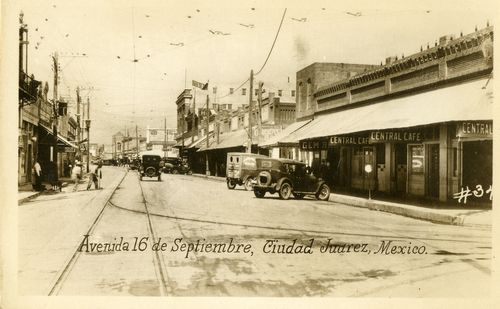
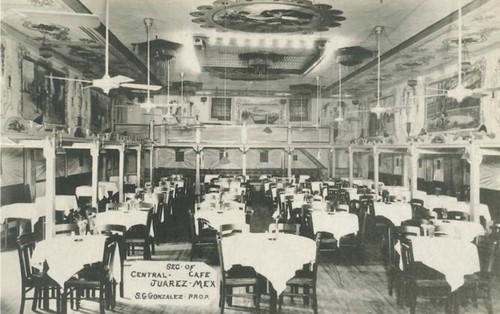
Founded in 1907, the Central Café, unlike most Prohibition era cabarets, was initially a traditional dining and entertainment venue designed to appeal to Mexican and American families. The dining room of the café was simple, tidy, and efficient, and the walls surrounding the space was covered with hand painted murals of classic Mexican scenes. The kitchen was staffed with Mexican cooks who prepared family style meals that attracted a steady clientele.
The Central Café was owned and operated by Severo G. González, a Mexican-American from El Paso who became something of a local celebrity through his enterprising accomplishments. In addition to the Central Café González was a tireless sports promoter. In 1926 he opened the New Tivoli Cockpit that would stage prize cockfights, and in the same year he partnered with other investors to build and operate the Juárez Coliseum, a twelve thousand-seat open- air sports arena for prize fights, wrestling matches, dog races, bicycle races, and track meets.
The Central Café was located at 461 16 de Septiembre at the corner with Avenida Lerdo, where the southbound streetcar turned west on to the town’s main street.
When Prohibition began to transform dining establishments in Juárez to bar- cafés and cabarets, González played right along. Like other proprietors González converted part of his establishment to a full- blown bar complete with slot machines.
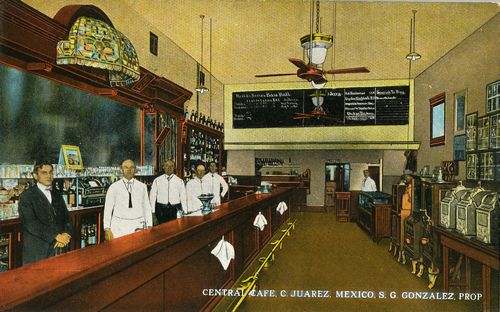
In 1924, González opened the Central Café No. 2, and, unlike the original, the interior was lavishly decorated with purple draperies with gold fringe wall furnishings and satin-shade-covered table lamps surrounding a dance floor. The menu was elevated to include wild game dishes to appeal to the demands of Prohibition era diners. Additionally, the Central Café establishments— the original and No. 2— boasted the only air conditioning systems in place among Ciudad Juárez cabarets.
During the 1920s the Central Café featured live orchestral entertainment, a necessary ingredient to successful Juárez cabarets. The Central Café became an institution in Ciudad Juárez, a first-class cabaret that helped set the standard for sophisticated dining and dancing in the city. Regardless, Prohibition in the United States was repealed in 1933, and the Mexican federal government, under Lázaro Cárdenas, outlawed casino gambling in 1934. The death knell to the cabaret scene in Ciudad Juárez had sounded. Referring to the operation of the Central Café, S. G. González placed an advertisement in the El Paso Times on 27 March 1934 that said it all: “We will be open all this week, including Sunday, with the usual service, good food, and good music. Then adios”Information on this and other bars from Daniel D. Arreola, Postcards from the Chihuahua Border: Revisiting a Pictorial Past, 1900s–1950s, University of Arizona Press, 2019.
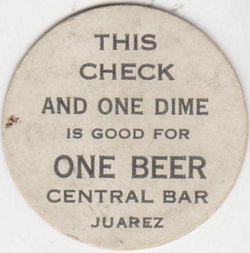
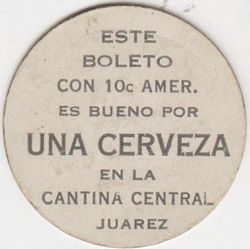
Obverse: THIS CHECK / AND ONE DIME / IS GOOD FOR / ONE BEER / CENTRAL BAR / JUAREZ
Reverse: ESTE BOLETO / CON 10c AMER. / ES BUENO POR / UNA CREVEZA / EN LA / CANTINA CENTRAL / JUAREZ
35mm. cardboard
Dieter & Sauer
This firm was founded in Ciudad Juárez by John Phillip Dieter and George D. Sauer.
 Born Johan Philipp Dieter in Gross-Biberhau, Germany, on 2 February 1851, Dieter came to the United States as a young man and married his first wife, Anna E. McNeal, on 12 November 1873. The couple lived in Wichita, Kansas, and produced three children all of whom were victims of a cholera epidemic there. He met and befriended Amos L. Houck in Wichita and arrived in El Paso prior to the arrival of the railroads in 1881, and with Houck t the firm of Houck & Dieter, the first soda water manufacturer in El Paso. The El Paso Times described him as “a courteous gentleman thoroughly posted in all the details of this extensive manufactory, and is always ready to impart information to the many people who visit the works”El Paso Times, 10 January 1881.A later edition showed that Dieter may not always have been so courteous at home; his wife, Annie, divorced him on 22 October 1887El Paso Times, 23 October 1887. He soon remarried to Minna Sophie Henriette Bruhn, sister of his lifelong friend, Henning Bruhn.
Born Johan Philipp Dieter in Gross-Biberhau, Germany, on 2 February 1851, Dieter came to the United States as a young man and married his first wife, Anna E. McNeal, on 12 November 1873. The couple lived in Wichita, Kansas, and produced three children all of whom were victims of a cholera epidemic there. He met and befriended Amos L. Houck in Wichita and arrived in El Paso prior to the arrival of the railroads in 1881, and with Houck t the firm of Houck & Dieter, the first soda water manufacturer in El Paso. The El Paso Times described him as “a courteous gentleman thoroughly posted in all the details of this extensive manufactory, and is always ready to impart information to the many people who visit the works”El Paso Times, 10 January 1881.A later edition showed that Dieter may not always have been so courteous at home; his wife, Annie, divorced him on 22 October 1887El Paso Times, 23 October 1887. He soon remarried to Minna Sophie Henriette Bruhn, sister of his lifelong friend, Henning Bruhn.
Prior to his remarriage, Dieter had lived at the Grand Central Hotel, but the couple moved to 302 S. Stanton St. while waiting for the construction of their eleven room house at 404 Magoffin Ave. – not completed until 1898. By the turn of the century, Dieter was president of the El Paso Cigar Manufacturing Company, president of Consumers Ice Company, and president of the International Light and Power Company – along with his connections to Houck & Dieter and Dieter & Sauer. In 1905, he bought the El Paso Brewery out of receivership.
However, Dieter had another side that was less well known to the public. At some point, he met Etta Clark, a noted El Paso madam and one of the few Western women noted for being in a gunfight. Although married and the father of several children, the liquor wholesaler was so smitten with Etta that he agreed to finance the building and outfit a new brothel for her. Construction started on 1 January 1889 and the massive edifice was finished nine months later. The new bordello, located at the corner of Utah and Second streets, was three stories high and contained thirty-two rooms, including two parlour rooms, a huge dining room, an upstairs ballroom, and many, many bedrooms. The decor and furnishings were the finest: carved, gilded wood abounded, expensive murals were everywhere. Certain rooms were decorated in themes – a Red Room, a Blue Room, a Green Room – the place was truly as elegant as any in the United States.
Obviously, the place cost Dieter a bundle of money: $75,000 for construction, $50,000 for decorations and furnishings. But it cost the infatuated millionaire even more: his wife divorced him before the building had been completed, and taking their children, went back to her home in the East. Dieter remained in El Paso with “his Etta,” and although never married to each other, the two were like husband and wife for many years.
J. Philip Dieter died on 23 September 1907Bill Lockhart, Bottles on the Border: The History and Bottles of the Soft Drink Industry in El Paso, Texas, 1881-2000, 2010.
Although Dieter & Sauer was first listed in the El Paso City Directory at the northwest corner of Calle del Comercio and Avenida Lerdo in 1898 it was probably in existence earlier, possibly as the second branch of the El Paso bottling works. Dieter & Sauer advertised itself as "Importers and Jobbers, Groceries, Liquors, Wines, Cigars"Buck’s 1902 El Paso Directory.
In 1906, the company moved across the Rio Grande to locate at 210 San Francisco St. with George D. Sauer as manager. The timing of the move is interesting but requires some background information. On 17 March 1858, the governor of Tamaulipas issued a decree establishing a Zona Libre (free zone) along his state’s adjoining border with the American state of Texas. The Zona Libre granted bordering towns special exemptions from the exorbitant tariff duties required by Mexico. For most of the nineteenth century, the zone remained active only in the Lower Rio Grande Valley, but Mexico extended the Zona Libre to the Pacific Ocean (including El Paso, later Ciudad Juárez) on 25 March 1884. These conditions encouraged firms in El Paso, Texas, to establish branches in El Paso, Mexico, or relocate across the Rio Grande. It is likely that Dieter & Sauer had chosen their location to take advantage of the zone’s favourable trade conditions. Mexican President Porfirio Díaz abolished the Zona Libre on 1 July 1905, thus removing the incentive for the firm’s Mexican location and probably hastening the move to El Paso the following year. The firm was no longer advertised in the city directories after Dieter’s death in 1907. Sauer went on to form the George G. Sauer & Company, “commission merchants, export and import” at 715 Myrtle Ave.Bill Lockhart, Bottles on the Border: The History and Bottles of the Soft Drink Industry in El Paso, Texas, 1881-2000, 2010.
Grove 1330
Obverse: DIETER & SAUER / PASO / DEL NORTE / MEXICO.
Reverse: VALE / POR UNA / COPA
25mm. white nickel
Lemp's Cafe

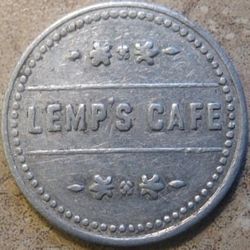
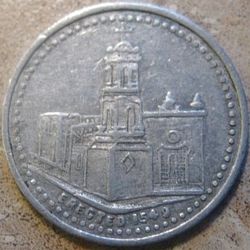
Obverse: LEMP'S CAFE
Reverse: mission ERECTED 1849
25mm. aluminum
The building on the reverse is the first church in the area, erected by the Franciscans who began to Christianize the natives. On 8 December 1659, Fray García de San Francisco founded the Guadalupe de los Mansos Mission on the Paso del Norte river. With the growth of Ciudad Juárez in the twentieth century, at the initiative of Father Baudelio Pelayo a new cathedral was built, attached to the old church, and consecrated in 1941.
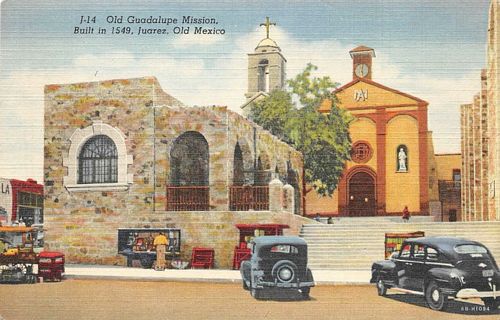
Lobby Cafe
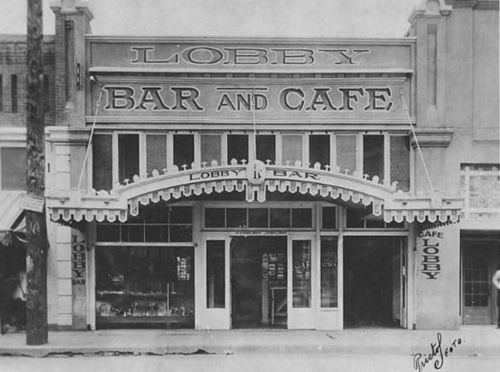
Lobby Café, first location, 1920s
The Lobby Café opened by Hugo Bonaguidi and two associates, August Lammori and Frank Dispenza, was originally located on 16 de Septiembre. The enterprise was soon relocated to Avenida Juárez, close to the international bridge, where it occupied a building previously housing the Paris Café and Bar.
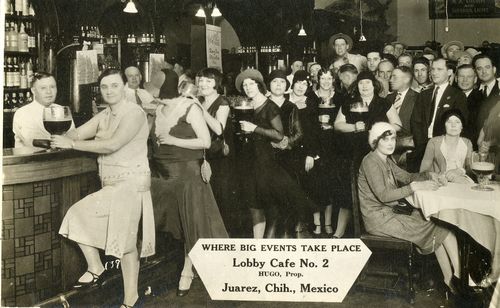
At its new location, the establishment became known as the Lobby Café No. 2, and later, when ownership shifted to Fred Borland, simply the Lobby Café. The Lobby quickly gained a reputation as a first-class supper bar where a staff of thirty waiters, bus boys, bartenders, chefs, and hatcheck girls provided efficient service.
The Lobby Café No 2 under Fred Borland began to use radio station XEJ to live broadcast its orchestral entertainment.
Obverse:
Reverse:
28mm. nickel plated on brass
Monterrey Bar
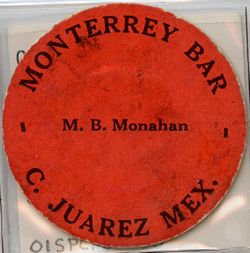
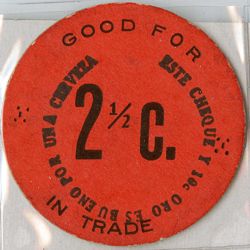
Obverse: MONTERREY BAR / M.B. MONAHAN / C. JUAREZ MEX.
Reverse: GOOD FOR / 2½ C. / IN TRADE (over-stamped upside down: ESTE CHEQUE Y 10c ORO ES BUENO POR UNA CERVEZA)
24mm. cardboard
The Parlor

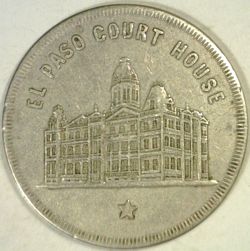
Obverse:. GOOD FOR 1 DRINK AT THE PARLOR / EL PASO / TEX / OLD CHURCH AGE 270 YEARS / PASO DEL NORTE, MEX.
Reverse: EL PASO COURT HOUSE
Since the Guadalupe de los Mansos Mission was founded in 1649 this token can be dated to 1919.
Toltec Bar
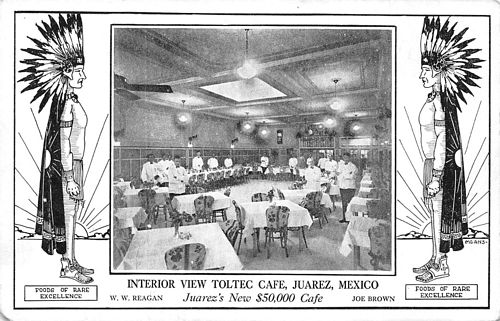
Like other establishments The Toltec Cafe became the Toltec Bar with Prohibition.
Obverse: TOLTEC / BAR / JUAREZ. / MEXICO
Reverse: THIS CHECK / AND / 10¢ / GOOD FOR ONE / BEER
28mm. tin plated steel
Later clubs
Chava's Club
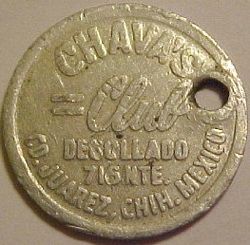
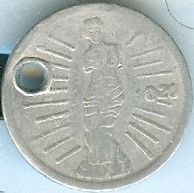
Obverse: CHAVA'S / Club / DESGOLLADO / 715 NTE. / CD. JUAREZ, CHIH. MEXICO
Reverse: Venus de Milo $0.20
Club Año Nuevo
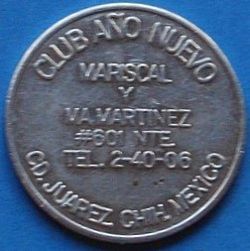
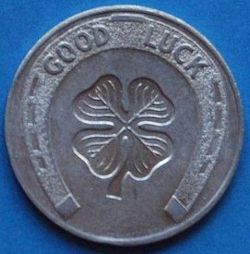
Obverse: CLUB AÑO NUEVO / MARISCAL / Y / MA. MARTINEZ / #601 NTE / TEL. 2-40-06 / CD. JUAREZ CHIH. MEXICO
Reverse: GOOD LUCK
Club Chihuahua
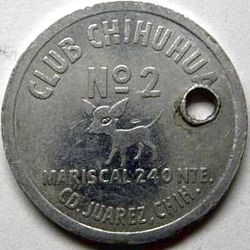
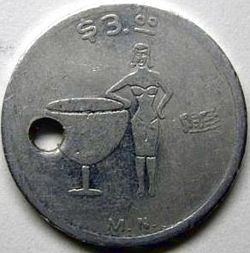
Obverse: CLUB CHIHUAHUA / No 2 / MARISCAL 240 NTE. / CD. JUAREZ, CHIH.
Reverse: $3.00
25mm. aluminum
Club Circulo

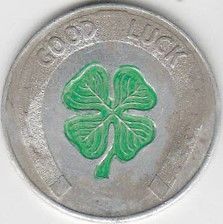
Obverse: CLUB / CIRCULO / RAFAEL VALARDE 440 SUR. / TEL. 2-55-51 / CD. JUAREZ, CHIH.
Reverse: GOOD LUCK
Club La Capital
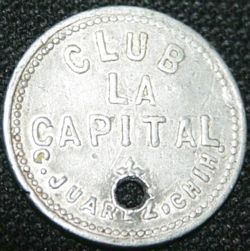
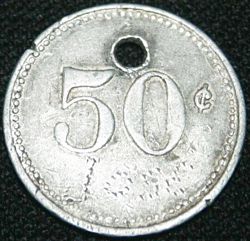
Obverse: CLUB / LA / CAPITAL / C. JUAREZ. CHIH.
Reverse: 50¢
Conquistador
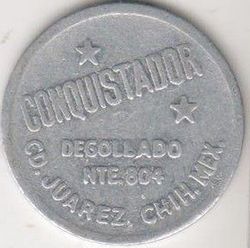
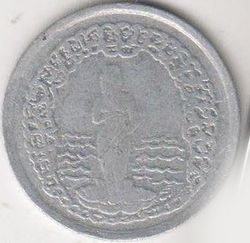
Obverse: CONQUISTADOR / DEGOLLADO / NTE 604 / CD. JUAREZ, CHIH. MEX.
Reverse: Venus rising from the waves
Doll House
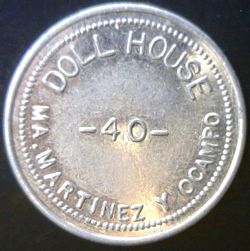
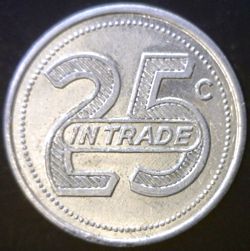
Obverse: DOLL HOUSE / 40 / MA. MARTINEZ Y OCAMPO
Reverse: 25c / IN TRADE
Erma's

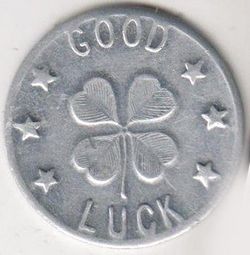
Obverse: THE NEW / ERMA's CLUB / OPEN 24 HOURS / EXCLUSIVELY / FOR / GENTLEMEN / CD. JUAREZ, CHIH. MEXICO
Reverse: GOOD / LUCK
Ginny's Club
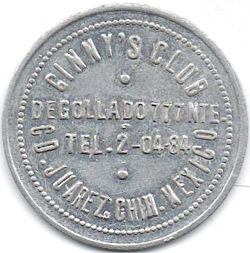
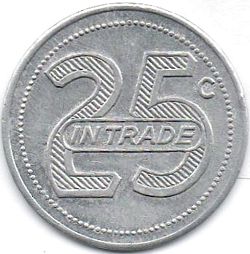
Obverse: GINNY'S CLUB / DEGOLLADO 777 NTE / TEL-2-04-84 / CD. JUAREZ. CHIH. MEXICO
Reverse: 25c / IN TRADE
29mm. aluminum
Golden Nights
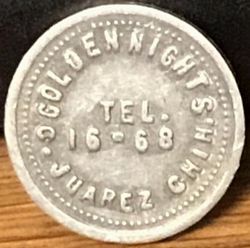
Obverse: GOLDEN NIGHTS / TEL. / 16-68 / C. JUAREZ CHIH.
Reverse:
Irma's
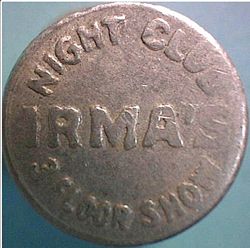
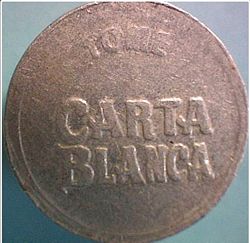
Obverse: NIGHT CLUB / IRMA'S / 3 FLOOR SHOW
Reverse: TOME / CARTA / BLANCA
18mm. aluminum
Largo Blanco Club / White Lake Club
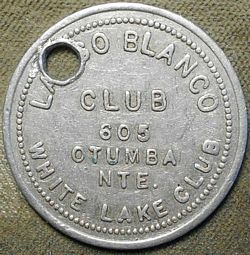
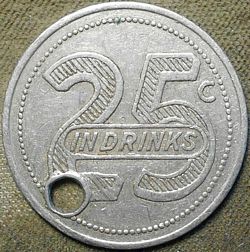
Obverse: LARGO BLANCO / CLUB / 605 / OTUMBA / NTE. / WHITE LAKE CLUB
Reverse: 25c / IN DRINKS
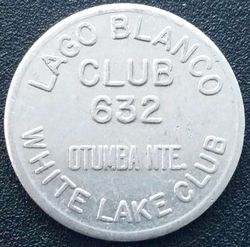
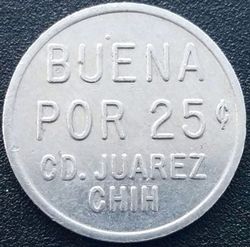
Obverse: LARGO BLANCO / CLUB / 632 / OTUMBA / NTE. / WHITE LAKE CLUB
Reverse: BUENA / POR 25¢ / CD. JUAREZ / CHIH
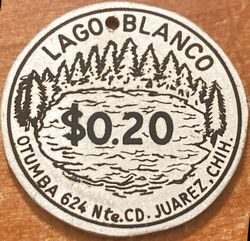
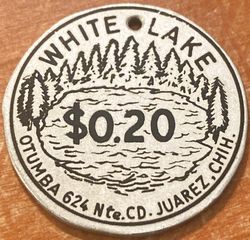
Obverse: WHITE LAKE / $0.20 / OTUMBA 624 Nte. CD. JUAREZ, CHIH.
Reverse: LAGO BLANCO / $0.20 / OTUMBA 624 Nte. CD. JUAREZ, CHIH.
27mm. aluminum
Red Room
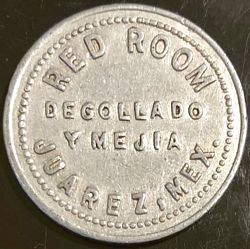
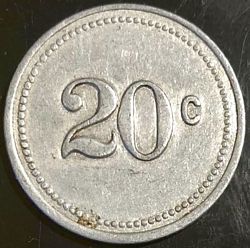
Obverse: RED ROOM / DEGOLLADO / Y MEJIA / JUAREZ, MEX.
Reverse: 20c
23mm. aluminum
Sans Sauci
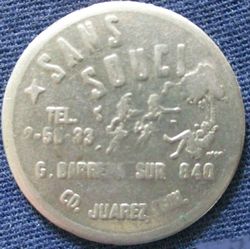
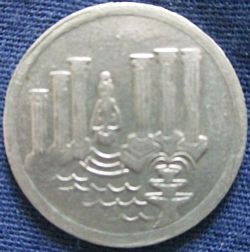
Obverse: SANS / SOUCI / TEL. / 2-66-33 / G. BARRERA SUR 840 / CD. JUAREZ, CHIH.
Reverse:
24mm. aluminum
Sarawak Discoteque
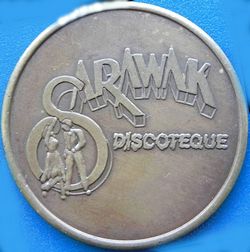
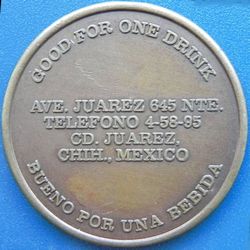
Obverse: SARAWAK / DISCOTEQUE
Reverse: GOOD FOR ONE DRINK / AVE JUAREZ 645 NTE. / TELEFONO 4-58-95 / CD. JUAREZ / CHIH, MEXICO / BUENO POR UNA BEBIDA
34mm. bronze

